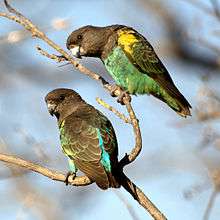Meyer's parrot
| Meyer's parrot | |
|---|---|
 | |
| P. m. transvaalensis pair in Zimbabwe | |
| Scientific classification | |
| Kingdom: | Animalia |
| Phylum: | Chordata |
| Class: | Aves |
| Order: | Psittaciformes |
| Superfamily: | Psittacoidea |
| Family: | Psittacidae |
| Subfamily: | Psittacinae |
| Genus: | Poicephalus |
| Species: | P. meyeri |
| Binomial name | |
| Poicephalus meyeri Cretzschmar, 1827 | |
 | |
| range and subspecies | |
Meyer's parrot or Brown parrot[2] (Poicephalus meyeri) is a smallish (about 21 cm, 90-130g) but stocky African parrot. Meyer's parrots display a dull brown head, back and tail, green or blue-green abdomen, blue rump and bright yellow markings on the carpal joint of the wings. Most subspecies have some yellow on the top of the head as well. Forshaw (1989) recognizes six subspecies of P. meyeri which vary in home range, size and in markings, including the extent of yellow markings to the head and wings and the intensity of turquoise markings on the abdomen and rump. Its name commemorates the German ornithologist Bernhard Meyer.[3]
Taxonomy
The six subspecies are:
- P. m. meyeri (Cretzschmar, 1827) — s Chad to w Ethiopia
- P. m. saturatus (Sharpe, 1901) — Uganda and w Kenya to w Tanzania
- P. m. matschiei (Neumann, 1898) — c Tanzania, se Congo, Zambia and n Malawi
- P. m. reichenowi (Neumann, 1898) — c Angola to s Congo
- P. m. damarensis (Neumann, 1898) — n Namibia, s Angola and nw Botswana
- P. m. transvaalensis (Neumann, 1899) — Botswana, Zimbabwe and n South Africa
Subspecies P. m. damarensis and P. m. reichenowi lack yellow markings on the head, while P. m. transvaalensis may have little to no yellow on the head. Belly and rump colours vary according to subspecies from turquoise or blue to green.
Range and habitat
Meyer's parrots are native to the plateau woodlands of sub-Saharan Africa where they occur in several woodland types including miombo, savanna woodlands, wooded grasslands and forests bordering watercourses or agricultural land. They are found in high densities in the Okavango Delta region of Botswana. They are also found in southern and Central, Africa (Chad, Sudan, South Sudan, Ethiopia, Congo, Angola, Tanzania, Zambia, Zimbabwe, Mozambique, and Namibia.
Behaviour
Food and feeding
Their wild diet includes fruit, seeds, nuts, berries and cultivated crops. Seeds of the various leguminous trees of the African woodlands are especially favoured, providing their staple food in some areas. Although they normally travel in pairs or small flocks, wild Meyer's parrots may gather in much larger numbers where food is plentiful. In drought years they wander in search of food.
Breeding
The Meyer's parrot nests in tree cavities. The eggs are white and there are usually three or four in a clutch. The female incubates the eggs for about 28 days and the chicks leave the nest about 60 days after hatching.[4]
Conservation status


Meyer's parrots are still common in the wild, although numbers have decreased locally following destruction of woodlands. It is generally not considered to be at risk,[1] as their large population, limited pressure from trade and hunting, and 6,000,000 km² home range make these birds unlikely to face extinction in the near future. Trade in Meyer's parrots that have been bred in aviculture is legal. Meyer's parrots are listed on Appendix II of the Convention on International Trade in Endangered Species of Wild Flora and Fauna. Appendix II listing means the species can also be taken from the wild and traded in 'limited' numbers.
Pet parrots
Meyer's parrots are commonly bred for the pet trade. They are relatively quiet and small and are able to learn dozens of words.
A three-year-old pet 
Captive pair
References
- 1 2 BirdLife International (2012). "Poicephalus meyeri". IUCN Red List of Threatened Species. Version 2013.2. International Union for Conservation of Nature. Retrieved 26 November 2013.
- ↑ The Internet Bird Collection
- ↑ Beolens, Bo; Watkins, Michael (2003). Whose Bird? Men and Women Commemorated in the Common Names of Birds. London: Christopher Helm. p. 234.
- ↑ Alderton, David (2003). The Ultimate Encyclopedia of Caged and Aviary Birds. London, England: Hermes House. p. 223. ISBN 1-84309-164-X.
- Forshaw, Joseph M. and William T. Cooper. 1989. Parrots of the World. Third (Revised) Edition. Landsdowne Editions, Melbourne.
- Jordan, Rick and Jean Pattison. 1999. African Parrots. Hancock House, Blaine, WA.
- Wirminghaus, J.O., Meyer's Parrot. In: The atlas of southern African birds. Vol. 1: Non-passerines. 1997. ISBN 0-620-20729-9.
External links
- Meyer's parrot - Species text in The Atlas of Southern African Birds.
